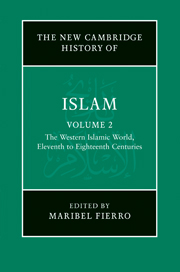Book contents
- Frontmatter
- Introduction
- PART I AL-ANDALUS AND NORTH AND WEST AFRICA (ELEVENTH TO FIFTEENTH CENTURIES)
- 1 Al-Andalus and the Maghrib (from the fifth/eleventh century to the fall of the Almoravids)
- 2 The central lands of North Africa and Sicily, until the beginning of the Almohad period
- 3 The Almohads (524–668/1130–1269) and the Ḥafṣids (627–932/1229–1526)
- 4 The post-Almohad dynasties in al-Andalus and the Maghrib (seventh–ninth/thirteenth–fifteenth centuries)
- 5 West Africa and its early empires
- PART II EGYPT AND SYRIA (ELEVENTH CENTURY UNTIL THE OTTOMAN CONQUEST)
- PART III MUSLIM ANATOLIA AND THE OTTOMAN EMPIRE
- PART IV NORTH AND WEST AFRICA (SIXTEENTH TO EIGHTEENTH CENTURIES)
- PART V RULERS, SOLDIERS, PEASANTS, SCHOLARS AND TRADERS
- Glossary
- Bibliography
- Index
- References
2 - The central lands of North Africa and Sicily, until the beginning of the Almohad period
from PART I - AL-ANDALUS AND NORTH AND WEST AFRICA (ELEVENTH TO FIFTEENTH CENTURIES)
Published online by Cambridge University Press: 28 March 2011
- Frontmatter
- Introduction
- PART I AL-ANDALUS AND NORTH AND WEST AFRICA (ELEVENTH TO FIFTEENTH CENTURIES)
- 1 Al-Andalus and the Maghrib (from the fifth/eleventh century to the fall of the Almoravids)
- 2 The central lands of North Africa and Sicily, until the beginning of the Almohad period
- 3 The Almohads (524–668/1130–1269) and the Ḥafṣids (627–932/1229–1526)
- 4 The post-Almohad dynasties in al-Andalus and the Maghrib (seventh–ninth/thirteenth–fifteenth centuries)
- 5 West Africa and its early empires
- PART II EGYPT AND SYRIA (ELEVENTH CENTURY UNTIL THE OTTOMAN CONQUEST)
- PART III MUSLIM ANATOLIA AND THE OTTOMAN EMPIRE
- PART IV NORTH AND WEST AFRICA (SIXTEENTH TO EIGHTEENTH CENTURIES)
- PART V RULERS, SOLDIERS, PEASANTS, SCHOLARS AND TRADERS
- Glossary
- Bibliography
- Index
- References
Summary
Introduction
The crisis of the Islamic world in the fifth/eleventh century, when the lands of the former Arab empire were overrun by barbarians from beyond its borders – Turks in the east, Berbers in the west – was brought about in the central Mediterranean by the invasion of Ifrīqiya by the Arab tribes of the Banū Hilāl and the invasion of Sicily by the Normans. Ifrīqiya was the old Byzantine province of Africa, from eastern Algeria to Tripolitania; Sicily had been conquered and annexed to Ifrīqiya in the third/ninth century, but had become independent when the Fāṭimids left for Egypt in 361/972. The Arab invasion put an end to central government in Ifrīqiya, while that of the Normans imposed a Christian monarchy upon Sicily. In the middle of the sixth/twelfth century the Normans briefly took possession of the Ifrīqiyan littoral, but the adventure ended with the Almohad conquest in 554–5/1159–60. In the interval, Ifrīqiya had become a land of city-states and tribal lordships, while Norman rule in Sicily had prepared the way for the disappearance of its Muslim population in the course of the next century.
- Type
- Chapter
- Information
- The New Cambridge History of Islam , pp. 48 - 65Publisher: Cambridge University PressPrint publication year: 2010

